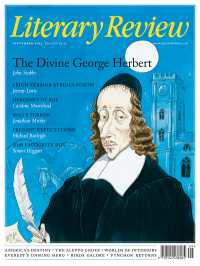Norma Clarke
London with the Many Sins
The First Bohemians: Life and Art in London’s Golden Age
By Vic Gatrell
Allen Lane/The Penguin Press 512pp £25
The Beau Monde: Fashionable Society in Georgian London
By Hannah Greig
Oxford University Press 368pp £25
What Vic Gatrell calls bohemians and what Hannah Greig calls the beau monde rubbed shoulders in London in the 18th century, though you would not think so from these books. Greig’s subjects, the people of fashion and privilege who formed an exclusive elite within the elite, are everything Gatrell hates. Their representative in The First Bohemians is Sir Joshua Reynolds, who painted them and moved in their circles. Gatrell’s focus is Covent Garden in its heyday, after the ‘Quality’ had left. As the area became a centre for writers and artists, so the ‘people of fascination’, as Henry Fielding put it, were driven out. They made their way westward to Hanover Square and beyond, their removal ‘unlamented’ by the theatre folk, musicians and artists who moved in to live and work alongside tradesmen, market people, pickpockets and prostitutes. Hogarth, who was born and lived his whole life in the neighbourhood, typified the new bohemian artist. His quasi-realist style conveyed the vivid life around him in images that challenged the neoclassicism promoted by Reynolds, a hugely successful society portrait painter and, later, the first president of the Royal Academy. The book glosses over the fact that Reynolds was every bit as bohemian as Hogarth, if by that we mean (as Gatrell seems to) a frequenter of Covent Garden’s taverns and bagnios, a heavy drinker and a customer for the sexual services available. On the whole, none of this emerged in Reynolds’s paintings, though the erotic portrait Cupid as a Link Boy gives one plenty to think about.
Hogarth’s narrative series A Harlot’s Progress first brought him fame. He was cashing in on the market for underworld and criminal tales first opened by novelists such as Daniel Defoe with Moll Flanders, and John Gay’s The Beggar’s Opera. As in print, so in painting: the power of wealthy patrons

Sign Up to our newsletter
Receive free articles, highlights from the archive, news, details of prizes, and much more.@Lit_Review
Follow Literary Review on Twitter
Twitter Feed
It wasn’t until 1825 that Pepys’s diary became available for the first time. How it was eventually decrypted and published is a story of subterfuge and duplicity.
Kate Loveman tells the tale.
Kate Loveman - Publishing Pepys
Kate Loveman: Publishing Pepys
literaryreview.co.uk
Arthur Christopher Benson was a pillar of the Edwardian establishment. He was supremely well connected. As his newly published diaries reveal, he was also riotously indiscreet.
Piers Brendon compares Benson’s journals to others from the 20th century.
Piers Brendon - Land of Dopes & Tories
Piers Brendon: Land of Dopes & Tories - The Benson Diaries: Selections from the Diary of Arthur Christopher Benson by Eamon Duffy & Ronald Hyam (edd)
literaryreview.co.uk
Of the siblings Gwen and Augustus John, it is Augustus who has commanded most attention from collectors and connoisseurs.
Was he really the finer artist, asks Tanya Harrod, or is it time Gwen emerged from her brother’s shadow?
Tanya Harrod - Cut from the Same Canvas
Tanya Harrod: Cut from the Same Canvas - Artists, Siblings, Visionaries: The Lives and Loves of Gwen and Augustus John by Judith Mackrell
literaryreview.co.uk